sensor Alfa Romeo 166 2006 Owner handbook (in English)
[x] Cancel search | Manufacturer: ALFA ROMEO, Model Year: 2006, Model line: 166, Model: Alfa Romeo 166 2006Pages: 272, PDF Size: 4.17 MB
Page 68 of 272
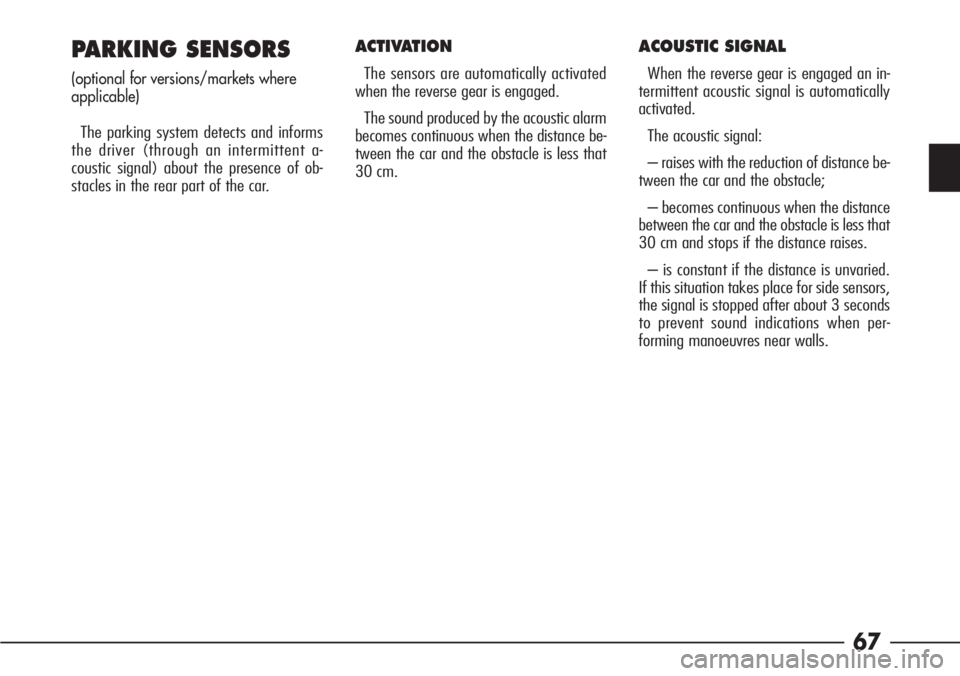
67
PARKING SENSORS
(optional for versions/markets where
applicable)
The parking system detects and informs
the driver (through an intermittent a-
coustic signal) about the presence of ob-
stacles in the rear part of the car.
ACTIVATION
The sensors are automatically activated
when the reverse gear is engaged.
The sound produced by the acoustic alarm
becomes continuous when the distance be-
tween the car and the obstacle is less that
30 cm.
ACOUSTIC SIGNAL
When the reverse gear is engaged an in-
termittent acoustic signal is automatically
activated.
The acoustic signal:
– raises with the reduction of distance be-
tween the car and the obstacle;
– becomes continuous when the distance
between the car and the obstacle is less that
30 cm and stops if the distance raises.
– is constant if the distance is unvaried.
If this situation takes place for side sensors,
the signal is stopped after about 3 seconds
to prevent sound indications when per-
forming manoeuvres near walls.
Page 76 of 272
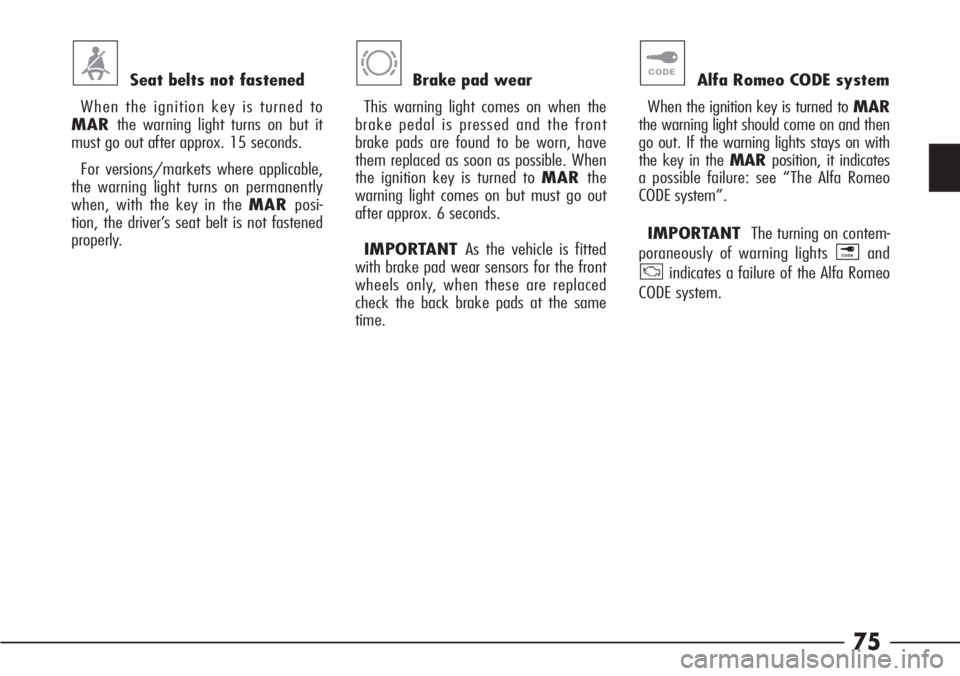
75
Seat belts not fastened
When the ignition key is turned to
MARthe warning light turns on but it
must go out after approx. 15 seconds.
For versions/markets where applicable,
the warning light turns on permanently
when, with the key in the MARposi-
tion, the driver’s seat belt is not fastened
properly.
brake pedal is pressed and the front
brake pads are found to be worn, have
them replaced as soon as possible. When
the ignition key is turned to MARthe
warning light comes on but must go out
after approx. 6 seconds.
IMPORTANT As the vehicle is fitted
with brake pad wear sensors for the front
wheels only, when these are replaced
check the back brake pads at the same
time.dAlfa Romeo CODE system
When the ignition key is turned to MAR
the warning light should come on and then
go out. If the warning lights stays on with
the key in the MARposition, it indicates
a possible failure: see “The Alfa Romeo
CODE system”.
IMPORTANT The turning on contem-
poraneously of warning lights and
indicates a failure of the Alfa Romeo
CODE system.
¢
¢
Page 92 of 272
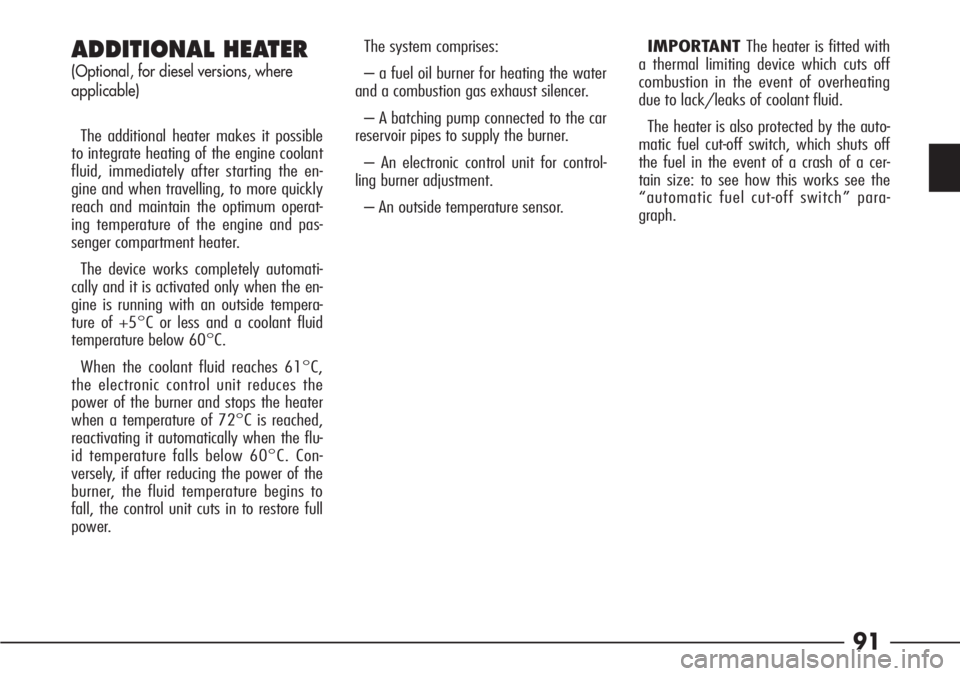
91
ADDITIONAL HEATER
(Optional, for diesel versions, where
applicable)
The additional heater makes it possible
to integrate heating of the engine coolant
fluid, immediately after starting the en-
gine and when travelling, to more quickly
reach and maintain the optimum operat-
ing temperature of the engine and pas-
senger compartment heater.
The device works completely automati-
cally and it is activated only when the en-
gine is running with an outside tempera-
ture of +5°C or less and a coolant fluid
temperature below 60°C.
When the coolant fluid reaches 61°C,
the electronic control unit reduces the
power of the burner and stops the heater
when a temperature of 72°C is reached,
reactivating it automatically when the flu-
id temperature falls below 60°C. Con-
versely, if after reducing the power of the
burner, the fluid temperature begins to
fall, the control unit cuts in to restore full
power.The system comprises:
– a fuel oil burner for heating the water
and a combustion gas exhaust silencer.
– A batching pump connected to the car
reservoir pipes to supply the burner.
– An electronic control unit for control-
ling burner adjustment.
– An outside temperature sensor.IMPORTANT The heater is fitted with
a thermal limiting device which cuts off
combustion in the event of overheating
due to lack/leaks of coolant fluid.
The heater is also protected by the auto-
matic fuel cut-off switch, which shuts off
the fuel in the event of a crash of a cer-
tain size: to see how this works see the
“automatic fuel cut-off switch” para-
graph.
Page 107 of 272

1024PGSm
fig. 137
106
OPENING FROM INSIDE
(fig. 136)
To open from inside:
– With the vehicle stationary, press but-
ton (A) inside the glovebox.
Due to its position, this control cannot
be operated when the glovebox is key-
locked.
REMOTE CONTROL OPENING
(
fig. 137)
(optional for the versions/markets where
applicable)
The luggage compartment may be re-
mote opened by pressing the push-button
(A-fig. 137) on the key with metallic
insert (B), even when the electronic
alarm is ON (where installed).In this case the alarm disengages the
boot control sensor, the system (with the
exception of versions for certain markets)
sounds two beeps and the direction indi-
cators light up for about three seconds.
When the boot is closed again the con-
trol function is restored, the system (with
the exception of versions for certain mar-
kets) sounds two beeps and the direction
indicators light up for about three seconds.
574PGSm
fig. 136
Page 116 of 272
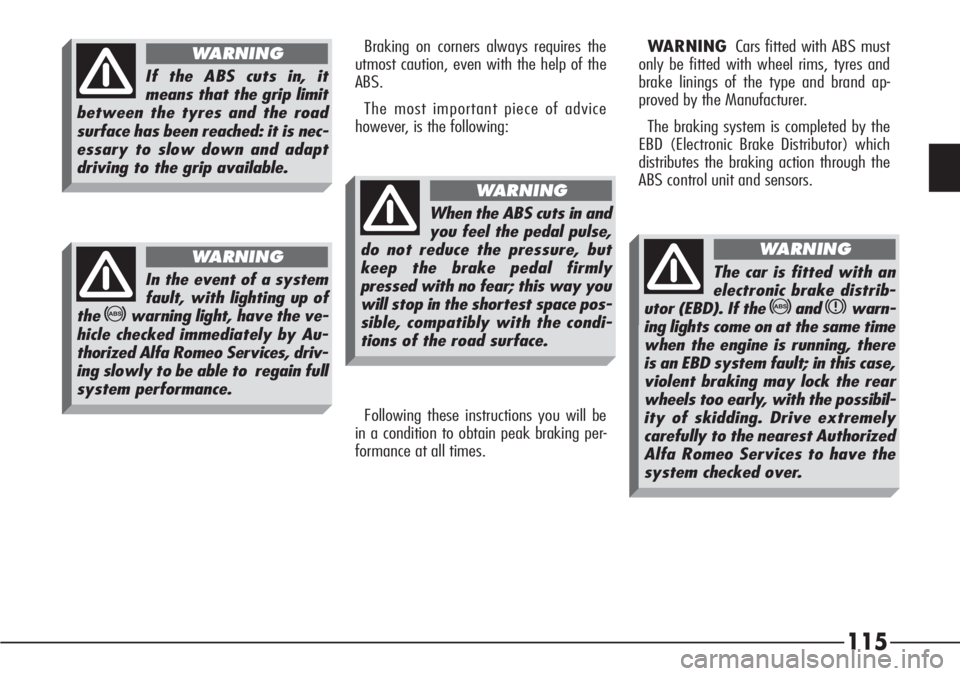
115
Braking on corners always requires the
utmost caution, even with the help of the
ABS.
The most important piece of advice
however, is the following:WARNINGCars fitted with ABS must
only be fitted with wheel rims, tyres and
brake linings of the type and brand ap-
proved by the Manufacturer.
The braking system is completed by the
EBD (Electronic Brake Distributor) which
distributes the braking action through the
ABS control unit and sensors.
Following these instructions you will be
in a condition to obtain peak braking per-
formance at all times.
If the ABS cuts in, it
means that the grip limit
between the tyres and the road
surface has been reached: it is nec-
essary to slow down and adapt
driving to the grip available.
WARNING
In the event of a system
fault, with lighting up of
the
>warning light, have the ve-
hicle checked immediately by Au-
thorized Alfa Romeo Services, driv-
ing slowly to be able to regain full
system performance.
WARNING
When the ABS cuts in and
you feel the pedal pulse,
do not reduce the pressure, but
keep the brake pedal firmly
pressed with no fear; this way you
will stop in the shortest space pos-
sible, compatibly with the condi-
tions of the road surface.
WARNING
The car is fitted with an
electronic brake distrib-
utor (EBD). If the
>andxwarn-
ing lights come on at the same time
when the engine is running, there
is an EBD system fault; in this case,
violent braking may lock the rear
wheels too early, with the possibil-
ity of skidding. Drive extremely
carefully to the nearest Authorized
Alfa Romeo Services to have the
system checked over.
WARNING
Page 118 of 272
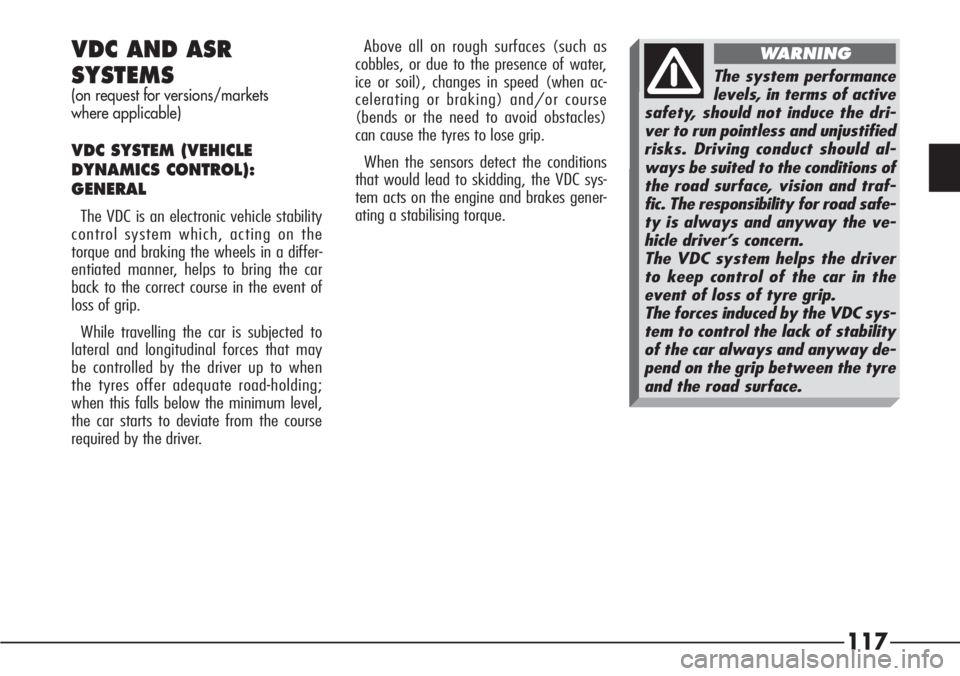
117
VDC AND ASR
SYSTEMS
(on request for versions/markets
where applicable)
VDC SYSTEM (VEHICLE
DYNAMICS CONTROL):
GENERAL
The VDC is an electronic vehicle stability
control system which, acting on the
torque and braking the wheels in a differ-
entiated manner, helps to bring the car
back to the correct course in the event of
loss of grip.
While travelling the car is subjected to
lateral and longitudinal forces that may
be controlled by the driver up to when
the tyres offer adequate road-holding;
when this falls below the minimum level,
the car starts to deviate from the course
required by the driver.Above all on rough surfaces (such as
cobbles, or due to the presence of water,
ice or soil), changes in speed (when ac-
celerating or braking) and/or course
(bends or the need to avoid obstacles)
can cause the tyres to lose grip.
When the sensors detect the conditions
that would lead to skidding, the VDC sys-
tem acts on the engine and brakes gener-
ating a stabilising torque.
The system performance
levels, in terms of active
safety, should not induce the dri-
ver to run pointless and unjustified
risks. Driving conduct should al-
ways be suited to the conditions of
the road surface, vision and traf-
fic. The responsibility for road safe-
ty is always and anyway the ve-
hicle driver’s concern.
The VDC system helps the driver
to keep control of the car in the
event of loss of tyre grip.
The forces induced by the VDC sys-
tem to control the lack of stability
of the car always and anyway de-
pend on the grip between the tyre
and the road surface.
WARNING
Page 119 of 272
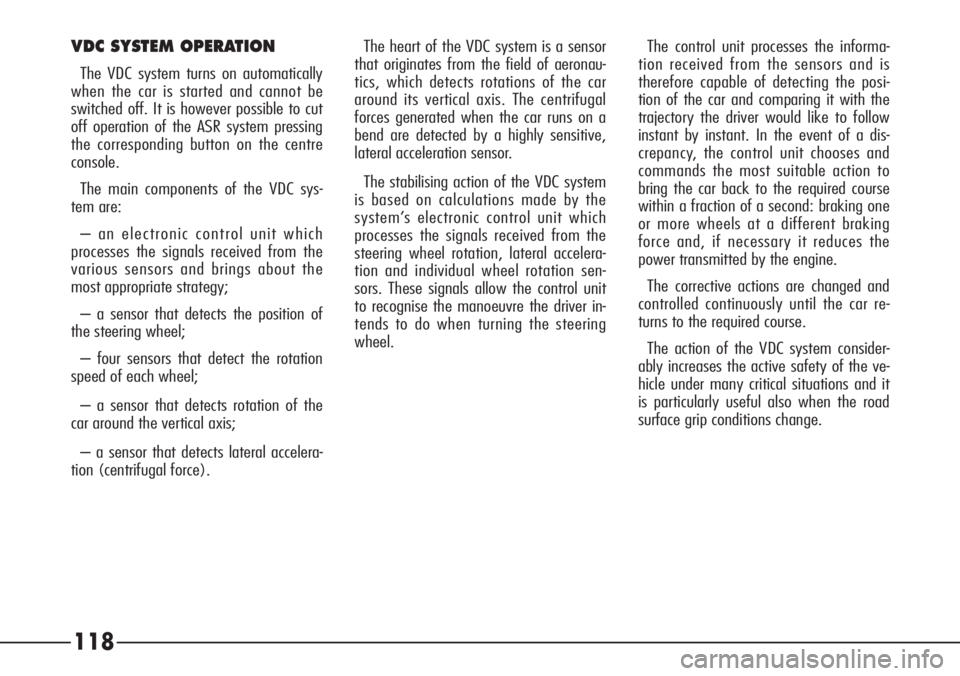
The heart of the VDC system is a sensor
that originates from the field of aeronau-
tics, which detects rotations of the car
around its vertical axis. The centrifugal
forces generated when the car runs on a
bend are detected by a highly sensitive,
lateral acceleration sensor.
The stabilising action of the VDC system
is based on calculations made by the
system’s electronic control unit which
processes the signals received from the
steering wheel rotation, lateral accelera-
tion and individual wheel rotation sen-
sors. These signals allow the control unit
to recognise the manoeuvre the driver in-
tends to do when turning the steering
wheel.
118
VDC SYSTEM OPERATION
The VDC system turns on automatically
when the car is started and cannot be
switched off. It is however possible to cut
off operation of the ASR system pressing
the corresponding button on the centre
console.
The main components of the VDC sys-
tem are:
– an electronic control unit which
processes the signals received from the
various sensors and brings about the
most appropriate strategy;
– a sensor that detects the position of
the steering wheel;
– four sensors that detect the rotation
speed of each wheel;
– a sensor that detects rotation of the
car around the vertical axis;
– a sensor that detects lateral accelera-
tion (centrifugal force).The control unit processes the informa-
tion received from the sensors and is
therefore capable of detecting the posi-
tion of the car and comparing it with the
trajectory the driver would like to follow
instant by instant. In the event of a dis-
crepancy, the control unit chooses and
commands the most suitable action to
bring the car back to the required course
within a fraction of a second: braking one
or more wheels at a different braking
force and, if necessary it reduces the
power transmitted by the engine.
The corrective actions are changed and
controlled continuously until the car re-
turns to the required course.
The action of the VDC system consider-
ably increases the active safety of the ve-
hicle under many critical situations and it
is particularly useful also when the road
surface grip conditions change.
Page 131 of 272
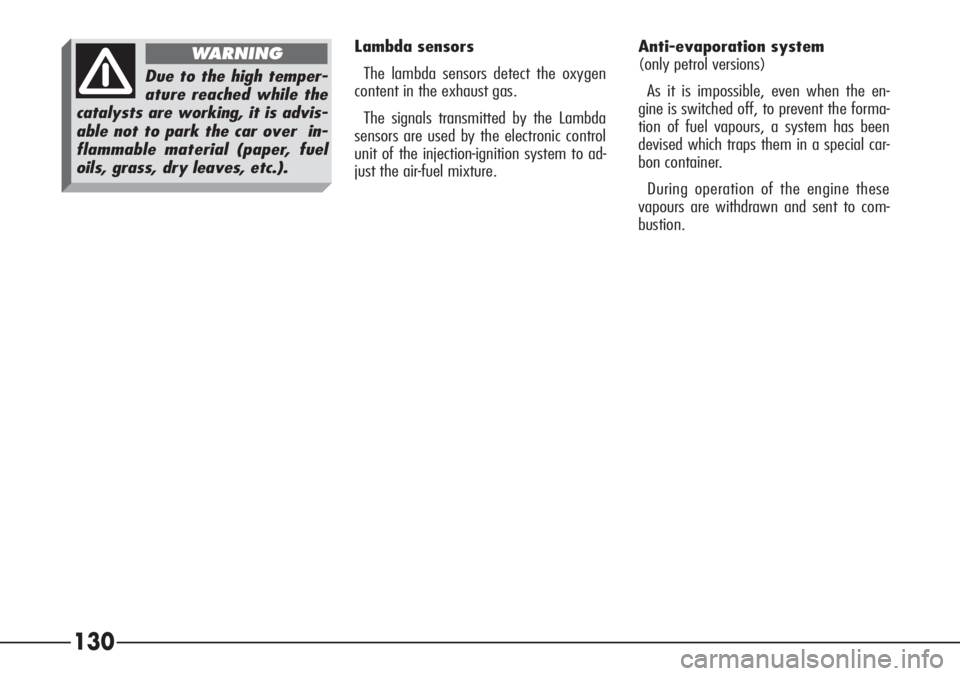
130
Lambda sensors
The lambda sensors detect the oxygen
content in the exhaust gas.
The signals transmitted by the Lambda
sensors are used by the electronic control
unit of the injection-ignition system to ad-
just the air-fuel mixture.Anti-evaporation system
(only petrol versions)
As it is impossible, even when the en-
gine is switched off, to prevent the forma-
tion of fuel vapours, a system has been
devised which traps them in a special car-
bon container.
During operation of the engine these
vapours are withdrawn and sent to com-
bustion.
Due to the high temper-
ature reached while the
catalysts are working, it is advis-
able not to park the car over in-
flammable material (paper, fuel
oils, grass, dry leaves, etc.).
WARNING
Page 142 of 272
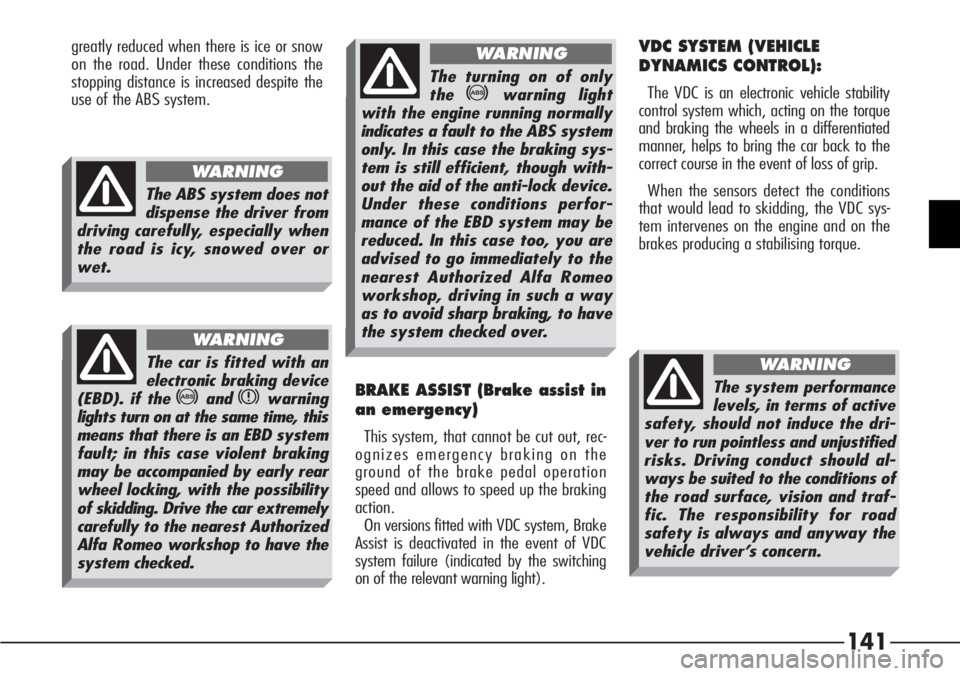
141
greatly reduced when there is ice or snow
on the road. Under these conditions the
stopping distance is increased despite the
use of the ABS system.VDC SYSTEM (VEHICLE
DYNAMICS CONTROL):
The VDC is an electronic vehicle stability
control system which, acting on the torque
and braking the wheels in a differentiated
manner, helps to bring the car back to the
correct course in the event of loss of grip.
When the sensors detect the conditions
that would lead to skidding, the VDC sys-
tem intervenes on the engine and on the
brakes producing a stabilising torque.
BRAKE ASSIST (Brake assist in
an emergency)
This system, that cannot be cut out, rec-
ognizes emergency braking on the
ground of the brake pedal operation
speed and allows to speed up the braking
action.
On versions fitted with VDC system, Brake
Assist is deactivated in the event of VDC
system failure (indicated by the switching
on of the relevant warning light).
The ABS system does not
dispense the driver from
driving carefully, especially when
the road is icy, snowed over or
wet.
WARNING
The car is fitted with an
electronic braking device
(EBD). if the
>andxwarning
lights turn on at the same time, this
means that there is an EBD system
fault; in this case violent braking
may be accompanied by early rear
wheel locking, with the possibility
of skidding. Drive the car extremely
carefully to the nearest Authorized
Alfa Romeo workshop to have the
system checked.
WARNING
The turning on of only
the
>warning light
with the engine running normally
indicates a fault to the ABS system
only. In this case the braking sys-
tem is still efficient, though with-
out the aid of the anti-lock device.
Under these conditions perfor-
mance of the EBD system may be
reduced. In this case too, you are
advised to go immediately to the
nearest Authorized Alfa Romeo
workshop, driving in such a way
as to avoid sharp braking, to have
the system checked over.
WARNING
The system performance
levels, in terms of active
safety, should not induce the dri-
ver to run pointless and unjustified
risks. Driving conduct should al-
ways be suited to the conditions of
the road surface, vision and traf-
fic. The responsibility for road
safety is always and anyway the
vehicle driver’s concern.
WARNING
Page 152 of 272
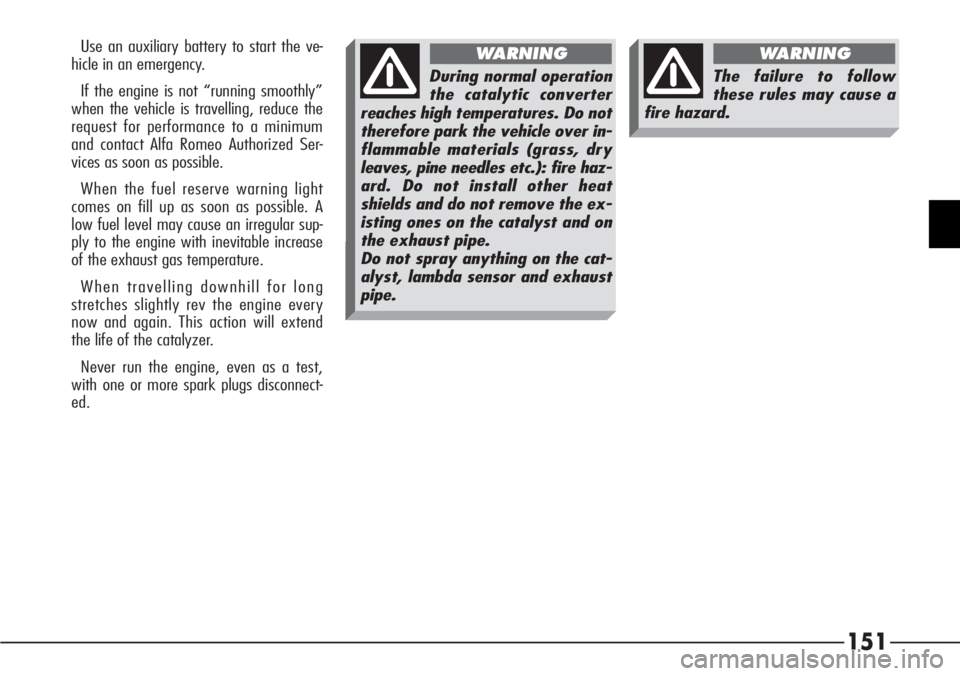
151
Use an auxiliary battery to start the ve-
hicle in an emergency.
If the engine is not “running smoothly”
when the vehicle is travelling, reduce the
request for performance to a minimum
and contact Alfa Romeo Authorized Ser-
vices as soon as possible.
When the fuel reserve warning light
comes on fill up as soon as possible. A
low fuel level may cause an irregular sup-
ply to the engine with inevitable increase
of the exhaust gas temperature.
When travelling downhill for long
stretches slightly rev the engine every
now and again. This action will extend
the life of the catalyzer.
Never run the engine, even as a test,
with one or more spark plugs disconnect-
ed.
During normal operation
the catalytic converter
reaches high temperatures. Do not
therefore park the vehicle over in-
flammable materials (grass, dry
leaves, pine needles etc.): fire haz-
ard. Do not install other heat
shields and do not remove the ex-
isting ones on the catalyst and on
the exhaust pipe.
Do not spray anything on the cat-
alyst, lambda sensor and exhaust
pipe.
WARNING
The failure to follow
these rules may cause a
fire hazard.
WARNING